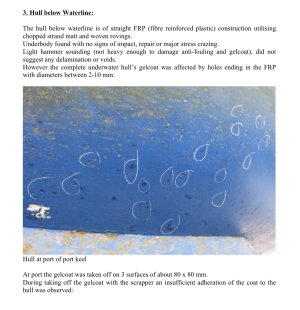Kirt86
New member
I recently had a survey done on my boat (1984 - been in the water for at least the last 8 years) which revealed some issues with the underwater gel coat.
The surveyor recommended a period out of the water, removal of gel coat and full reapplication, which I am considering, but does anyone have any experience of similar adhesion problems or alternative solutions (that wouldn’t mean the boat being out of the water for the majority of next year)?
Extract from survey report below:


The surveyor recommended a period out of the water, removal of gel coat and full reapplication, which I am considering, but does anyone have any experience of similar adhesion problems or alternative solutions (that wouldn’t mean the boat being out of the water for the majority of next year)?
Extract from survey report below:


